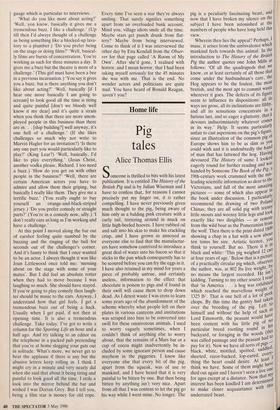Home life
Pig tales
Alice Thomas Ellis
Someone is thrilled to bits with his latest publication. It is entitled The History of the British Pig and is by Julian Wiseman and I have to confess that, for reasons I cannot precisely put my finger on, it is rather compelling. I have never previously given much thought to the pig, being aware of him only as a balding pink creature with a curly tail, teetering around in muck on little high-heeled hooves. I have rubbed oil and salt into his skin to make his crackling crisp, and I have grown as annoyed as everyone else to find that the manufactur- ers have somehow contrived to introduce a great deal of water into his bacon so that it sticks to the pan which consequently has to be scoured before you can fry the eggs in it. I have also retained in my mind for years a piece of probably untrue, and certainly useless, information to the effect that chocolate is poison to pigs and if found in their swill will cause them to drop down dead. As I detest waste I was cross to learn some years ago of the abandonment of the scheme whereby what people left on their plates in various canteens and institutions was scraped into bins to be converted into swill for these omnivorous animals. I used to worry vaguely sometimes, when I couldn't think of anything else to worry about, that the remains of a Mars bar or a cup of cocoa might inadvertently be in- cluded by some ignorant person and cause mayhem in the piggeries. I knew like everyone else that every bit of the pig, apart from the squeak, was of use to mankind, and I have heard that it is very painful to be bitten by one. But then being bitten by anything isn't very nice. Apart from all that I was content to let the pig go his way while I went mine. No longer. The pig is a peculiarly fascinating beast, and now that I have broken my silence on the subject I have been astonished at the numbers of people who have long held this view.
Wherein then lies the appeal? Perhaps, I muse, it arises from the ambivalence which mankind feels towards this animal. In the introduction to The History of the British Pig the author quotes one John Mills as follows: 'Of all the quadrupeds that we know, or at least certainly of all those that come under the husbandman's care, the Hog appears to be the foulest, the most brutish, and the most apt to commit waste wherever it goes. The defects of its figure seem to influence its dispositions: all its ways are gross, all its inclinations are filthy, and all its sensations concentrate In furious lust, and so eager a gluttony, that II devours indiscriminately whatever comes in its way.' Help. It seems particularly unfair to cast aspersions on the pig's figure, since an illustration of the common pig 0f Europe shows him to be as slim as you could wish and it is undoubtedly the hand of man that has fattened the hog. Having devoured The History of same I looked eagerly round for further reading and was handed by Someone The Book of the Pigi 3 19th-century work crammed with the mis- leading scientific information so dear to the Victorians, and full of the most amazln.g pictures — some of which also appear la the book under discussion. I particularlY recommend the drawing of two Poland Chinas; they are all solid pig with teensY little snouts and weensy little legs and look exactly like two dirigibles — as remote from the wild boar as the Pomeranian from the wolf. Then there is the print dated 1809 showing a chap in a hat with a sow about ten times his size. Artistic licence, think to yourself. But no. There it is la black and white: 'This pig weighed 12 04 at four years of age.' Below that is a picture of a practically circular pig which, observes the author, was, at 802 lbs live weight., by no means the largest recorded. He isn kidding. Turning to my other source! r.ea°. that 'in America . . . a hog was exhibitea, which reached the marvellous weight °I 1325 lb'. That is one hell of a lot of Pork chops. By this time the gentry had taken over the breeding of the pig. Left to himself and without the help of such as Lord Emsworth, the peasant would have been content with his little pig particular breed rootling round in a!s, backyard, or foraging in the woods Ohl' was called pannage and the peasant had ta pay for it). Now we have all sorts of plgs black, white, mottled, spotted, saddleo, sheeted, razor-backed, lop-eared, everY, thing the heart could desire. At least I_ think we have. Some of them might hay! died out again and I haven't seen a live one for ages except at a distance. Now thatirlY, interest has been kindled I am determine° to make closer acquaintance with underrated beast.


















































 Previous page
Previous page